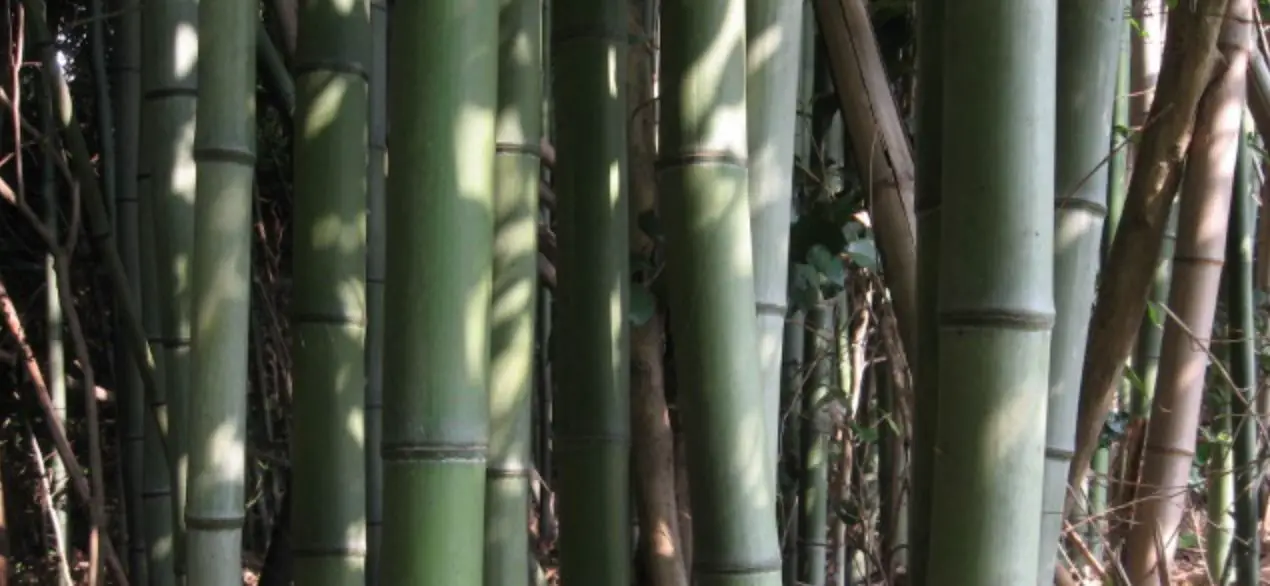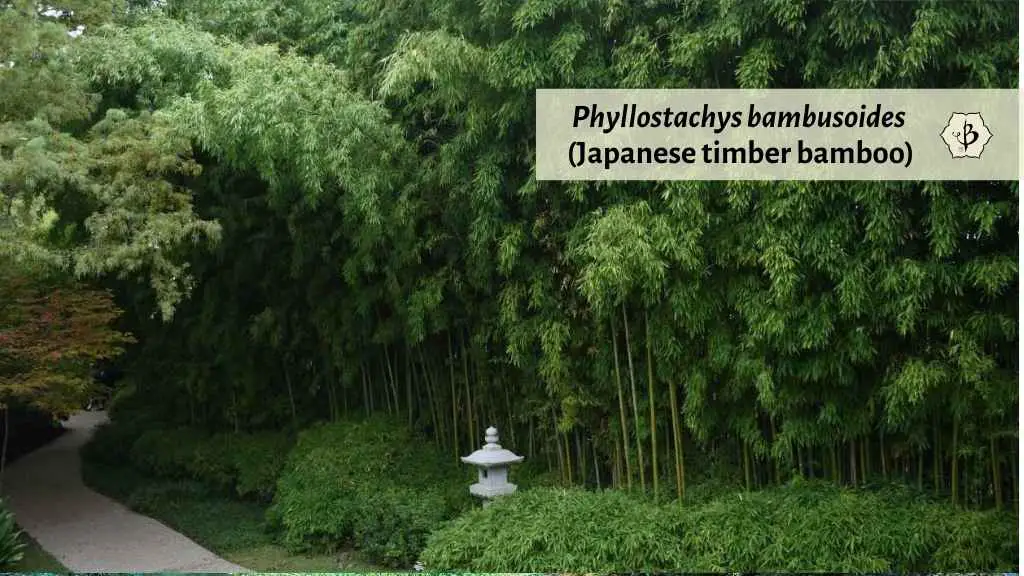Regal, upright, and elegant, Japanese Timber Bamboo is a classic species and a beautiful addition to any Asian-style garden. For ornamental purposes or for building material, Phyllostachys bambusoides has poles that are long, straight, and strong. A grove of this temperate species can form a magical forest or a stately privacy screen.
Phyllostachys bambusoides, also called Madake or Japanese Timer Bamboo, is a large species of running bamboo native to China and Japan. In ideal conditions, mature poles can grow 50 to 70 feet tall, and 4 to 5 inches in diameter. Culms and leaves have a rich green color, and the straight, towering stalks have a very majestic appearance. Plants are evergreen and cold hardy, and they grow well in most temperate climates.
This article is part of an ongoing series about different species and cultivars of bamboo. To learn more, check out some of these other detailed articles.
- BAMBOO SPECIES GUIDE
- A gallery of bamboo species
- Black Bamboo: Phyllostachys nigra and others
- Buddha’s Belly Bamboo
- Chimonobambusa quadrangularis: Square Bamboo
- Golden Bamboo: Phyllostachys aurea and others
- Hiroshima Bamboo
- Pseudosasa amabilis: Tonkin Bamboo
- Purple Bamboo: An online phenomenon
Phyllostachys bambusoides and other names
To avoid confusion, it’s best to refer to a bamboo species by its scientific name, using the genus and species. This is also known as binomial nomenclature. But even this method is imperfect, because sometimes the species get reclassified, moved from one genus to another, or renamed, like when P. pubescens became P. edulis (aka Moso).
However, scientific names aren’t always easy to remember or pronounce, so most growers refer to this variety as Japanese Timber Bamboo. In fact, it’s probably more native to China than Japan. In any case, it is widely cultivated in Japan, where they call it Madake. If you’re not sure how to pronounce that, think of the pronunciation of Karate, and that should help.
Characteristics of Japanese timber bamboo
Like all species of the genus Phyllostachys, P. bambusoides is a running bamboo with monopodial roots. Groves of this bamboo variety will have a tendency to spread and expand. Therefore, it’s important to have a containment strategy of some kind if you’re going to plant this in your garden.
P. bambusoides is also very cold-hardy like other runners. Like most kinds of Phyllostachys, they can tolerate winter temperatures as low as 5 or 10º below 0º F. Colder weather with likely cause frost damage to leaves and canes. But even so, the roots will probably survive, and fresh growth should reappear in the spring.

Japanese timber bamboo is one of the largest species of temperate or running bamboo. Comparable in size to Moso or Vivax, healthy specimens can easily exceed 50 or 60 feet in height. Culms can reach 4 or 5 inches in diameter. Younger canes may have more of a yellow color, but with age, they will turn a deep green. The lowest 8 to 12 feet of the poles tend to be bare and smooth, with dense, green foliage beginning around a quarter of the way up.
Similar to Moso and other timber bamboo varieties, Madake has an astonishing growth rate. At the peak of the growing season, new shoots can grow up to 3 feet a day. This makes it one of the fastest-growing plants on the planet. Flowering periods, by contrast, are among the longest of any bamboo species, going as much as 120 years between flowering events.
Uses for Phyllostachys bambusoides
Japanese Timber Bamboo is an excellent choice for a large ornamental species, as it makes a powerful impression. It also grows much more easily than Moso, and has more elegance than Vivax. It does especially well in the mild, moist climate of the Pacific Northwest.
The size and straightness of Madake poles make them useful for certain crafts and building applications. But the walls of this bamboo species are a bit too thin to be used for serious construction purposes. Even so, they can be used for decorative purposes to great effect. As the canes dry, they will turn from green to yellow. But the length and straightness are what lend the greatest aesthetic value.
Among other light crafts, traditional Shakhari flutes are commonly made from Madake bamboo. For this purpose, it’s necessary to harvest small poles from younger plants. These have thinner walls, and of course, narrower diameters.
The young shoots are considered edible, but bitter in taste. They are not as high quality and delicious as species like Moso and Henon. If you’re gathering them yourself, always be sure to boil your bamboo shoots before eating, to remove any natural toxins.
Further reading
If you’re fascinated by the many species and uses of bamboo and wish to learn more, then you’ve come to the right place. Bambu Batu has a wealth of in-depth articles about this miraculous grass.





















Hi, very interesting article. Thanks for all these info. Could you give us an idea of the yield of these different species? Expecially Henon vs Madake
Henon and Madake are pretty comparable in terms of yields per acre. Precise numbers are extremely difficult to pin down because so much depends on local soil and climate conditions, as well as management and maintenance practices.